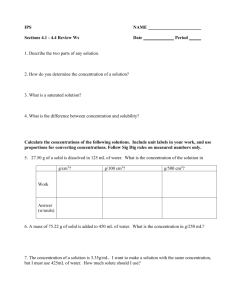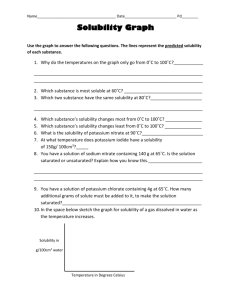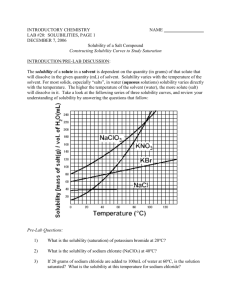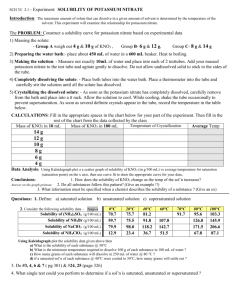Exploration Guide: Solubility and Temperature
advertisement
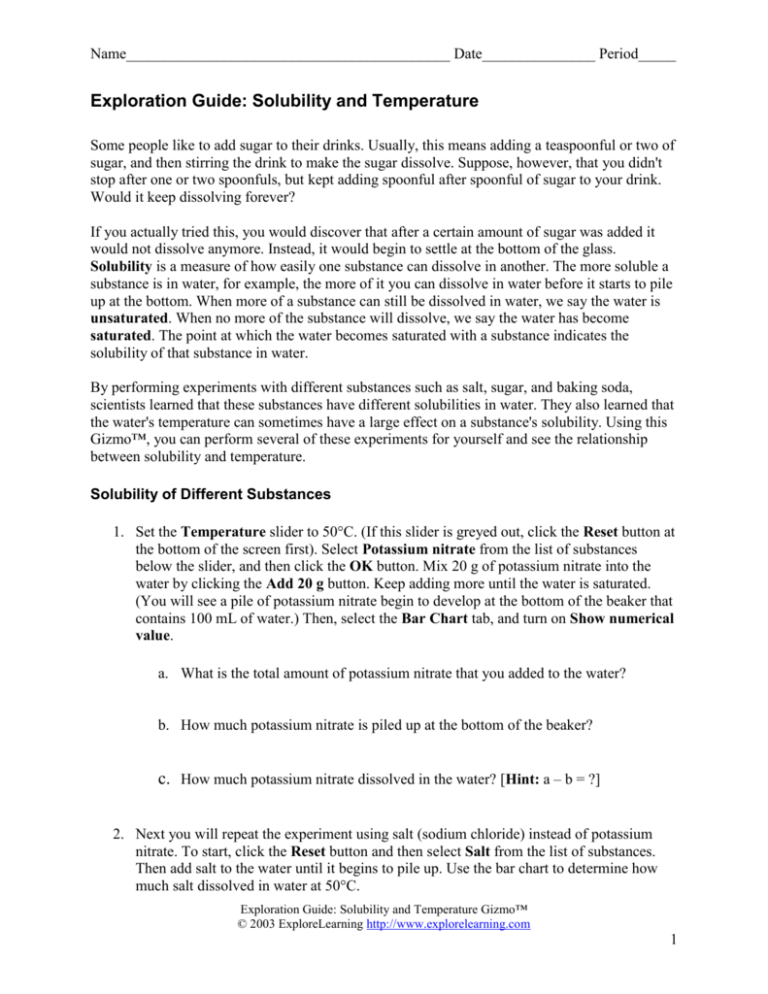
Name___________________________________________ Date_______________ Period_____ Exploration Guide: Solubility and Temperature Some people like to add sugar to their drinks. Usually, this means adding a teaspoonful or two of sugar, and then stirring the drink to make the sugar dissolve. Suppose, however, that you didn't stop after one or two spoonfuls, but kept adding spoonful after spoonful of sugar to your drink. Would it keep dissolving forever? If you actually tried this, you would discover that after a certain amount of sugar was added it would not dissolve anymore. Instead, it would begin to settle at the bottom of the glass. Solubility is a measure of how easily one substance can dissolve in another. The more soluble a substance is in water, for example, the more of it you can dissolve in water before it starts to pile up at the bottom. When more of a substance can still be dissolved in water, we say the water is unsaturated. When no more of the substance will dissolve, we say the water has become saturated. The point at which the water becomes saturated with a substance indicates the solubility of that substance in water. By performing experiments with different substances such as salt, sugar, and baking soda, scientists learned that these substances have different solubilities in water. They also learned that the water's temperature can sometimes have a large effect on a substance's solubility. Using this Gizmo™, you can perform several of these experiments for yourself and see the relationship between solubility and temperature. Solubility of Different Substances 1. Set the Temperature slider to 50°C. (If this slider is greyed out, click the Reset button at the bottom of the screen first). Select Potassium nitrate from the list of substances below the slider, and then click the OK button. Mix 20 g of potassium nitrate into the water by clicking the Add 20 g button. Keep adding more until the water is saturated. (You will see a pile of potassium nitrate begin to develop at the bottom of the beaker that contains 100 mL of water.) Then, select the Bar Chart tab, and turn on Show numerical value. a. What is the total amount of potassium nitrate that you added to the water? b. How much potassium nitrate is piled up at the bottom of the beaker? c. How much potassium nitrate dissolved in the water? [Hint: a – b = ?] 2. Next you will repeat the experiment using salt (sodium chloride) instead of potassium nitrate. To start, click the Reset button and then select Salt from the list of substances. Then add salt to the water until it begins to pile up. Use the bar chart to determine how much salt dissolved in water at 50°C. Exploration Guide: Solubility and Temperature Gizmo™ © 2003 ExploreLearning http://www.explorelearning.com 1 Name___________________________________________ Date_______________ Period_____ a. How much salt dissolved in the water at 50°C? b. Did more salt or potassium nitrate dissolve in the water at this temperature? Which substance is more soluble in water at 50°C, salt or potassium nitrate? c. When a substance begins to pile up at the bottom of the beaker, the water has become saturated with that substance. Can you keep dissolving more of the substance in the water after the water is saturated? Explain. 3. Press the Reset button, and set the Temperature slider to 80°C. Repeat the solubility experiment for potassium nitrate and for salt at this new, higher temperature. Write down your findings for each. a. How much potassium nitrate dissolves in water at 80°C before it starts to pile up? How much salt dissolves? b. How do your results at 80°C compare to those you obtained at 50°C? c. Was the solubility of potassium nitrate affected by the higher water temperature in the same way the solubility of salt was? Explain. Further Considerations 1. Find the solubility of potassium nitrate in water at each of the following temperatures: 5°C, 10°C, 15°C, 20°C, 25°C, 30°C, 35°C, 40°C, 45°C, 55°C, 60°C, 65°C, 70°C, 75°C, 85°C, 90°C, and 95°C. Write down this data along with your earlier data about salt dissolving in water. On paper, make a graph of your data. Put the temperature on the horizontal axis and grams dissolved on the vertical axis. For each temperature you tested, plot a point on the graph. a. Do the points on your graph increase or decrease from left to right? What does that tell you about how temperature affects solubility? Exploration Guide: Solubility and Temperature Gizmo™ © 2003 ExploreLearning http://www.explorelearning.com 2 Name___________________________________________ Date_______________ Period_____ b. Do the points on your graph form a straight line or a curve? What does the shape of the graph tell you about how temperature affects solubility? c. Repeat the above experiment with salt (sodium chloride). Solubility and Temperature Gizmo Data Table Temperature (C) 5 10 15 20 25 30 35 40 45 50 55 60 65 70 75 80 85 90 95 Potassium Nitrate (g/100 mL) Sodium Chloride (g/100 mL) Exploration Guide: Solubility and Temperature Gizmo™ © 2003 ExploreLearning http://www.explorelearning.com 3 Name___________________________________________ Date_______________ Period_____ Assessment Questions 1. I begin pouring salt into a glass of water. For a long time, the salt just dissolves in the water, but suddenly the salt begins to pile up at the bottom of the glass. Which statement is true? o o o o A. The salt has increased the temperature of the water. B. The salt has decreased the temperature of the water. C. The water is unsaturated. D. The water is saturated. 2. Imagine you have two beakers. Both beakers are filled with the same amount of water. The water in both beakers is the same temperature as well. You add 50 g of Substance A to the first beaker, and 50 g of Substance B to the second beaker. After stirring both beakers, there is a small pile of Substance A at the bottom of the first beaker. None of Substance B is visible in the second beaker. Which of the following statements is true? o o o o A. Substance A is less soluble in water than Substance B. B. Substance A is more soluble in water than Substance B. C. Substance A is not soluble in water. D. Substance B is not soluble in water. 3. Which one of the following graphs best describes the solubility of potassium nitrate (KNO3) in water at different temperatures? o o o o A. Graph A B. Graph B C. Graph C D. Graph D Exploration Guide: Solubility and Temperature Gizmo™ © 2003 ExploreLearning http://www.explorelearning.com 4

